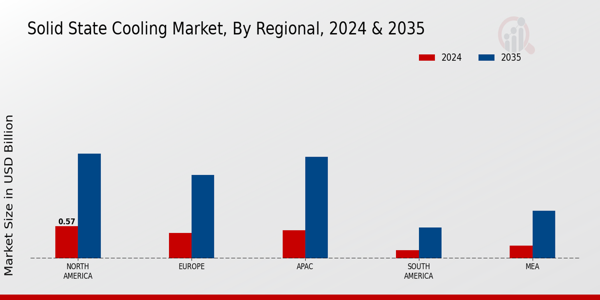Market Growth Projections
The Global Solid State Cooling Market Industry is projected to experience substantial growth over the next decade. With the market valued at 1.7 USD Billion in 2024, it is anticipated to escalate to 5.5 USD Billion by 2035. This growth trajectory suggests a compound annual growth rate of 11.26% from 2025 to 2035. Such projections indicate a robust demand for solid state cooling solutions across various sectors, driven by factors such as energy efficiency, technological advancements, and environmental considerations. The increasing investment in research and development further supports this optimistic outlook, positioning solid state cooling as a key player in the future of cooling technologies.
Rising Demand for Energy Efficiency
The Global Solid State Cooling Market Industry is experiencing a notable surge in demand for energy-efficient cooling solutions. As energy costs continue to rise, consumers and businesses alike are seeking alternatives that reduce energy consumption while maintaining optimal performance. Solid state cooling technologies, which utilize thermoelectric materials, offer an attractive solution due to their lower energy requirements compared to traditional cooling methods. This shift is reflected in the projected market growth, with the industry expected to reach 1.7 USD Billion in 2024 and potentially grow to 5.5 USD Billion by 2035, indicating a compound annual growth rate of 11.26% from 2025 to 2035.
Increasing Applications in Electronics Cooling
The Global Solid State Cooling Market Industry is witnessing a rapid expansion in applications related to electronics cooling. As electronic devices become more compact and powerful, the need for efficient thermal management solutions has intensified. Solid state cooling technologies offer a promising alternative to traditional cooling methods, providing effective heat dissipation without the moving parts that can lead to mechanical failure. This trend is particularly evident in sectors such as data centers, telecommunications, and consumer electronics, where maintaining optimal operating temperatures is critical. The growing reliance on solid state cooling in these applications is likely to drive market growth and innovation.
Technological Advancements in Cooling Solutions
Innovations in solid state cooling technologies are propelling the Global Solid State Cooling Market Industry forward. Advances in materials science and engineering have led to the development of more efficient thermoelectric devices, which are capable of providing effective cooling with minimal energy input. For instance, recent breakthroughs in nanostructured thermoelectric materials have demonstrated improved performance metrics, enhancing the overall efficiency of solid state cooling systems. As these technologies continue to evolve, they are likely to capture a larger share of the cooling market, appealing to sectors such as electronics, automotive, and HVAC, which increasingly prioritize energy efficiency and sustainability.
Environmental Regulations and Sustainability Initiatives
The Global Solid State Cooling Market Industry is being significantly influenced by stringent environmental regulations and a growing emphasis on sustainability. Governments worldwide are implementing policies aimed at reducing greenhouse gas emissions and promoting energy-efficient technologies. Solid state cooling systems, which do not rely on harmful refrigerants, align well with these regulatory frameworks. As industries seek to comply with environmental standards, the adoption of solid state cooling solutions is expected to rise. This trend not only supports corporate sustainability goals but also enhances brand reputation, making solid state cooling an appealing choice for businesses aiming to demonstrate environmental responsibility.
Consumer Awareness and Adoption of Advanced Cooling Technologies
The Global Solid State Cooling Market Industry is benefiting from increased consumer awareness regarding advanced cooling technologies. As individuals and businesses become more informed about the benefits of solid state cooling, including energy savings and reduced environmental impact, adoption rates are likely to rise. Educational initiatives and marketing efforts aimed at highlighting the advantages of solid state cooling systems are contributing to this trend. Furthermore, as consumers prioritize energy-efficient solutions in their purchasing decisions, manufacturers are responding by integrating solid state cooling technologies into their product offerings, thereby expanding the market reach and fostering growth.











